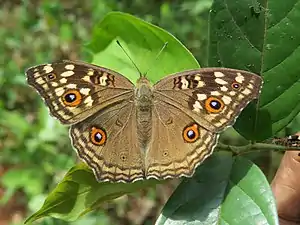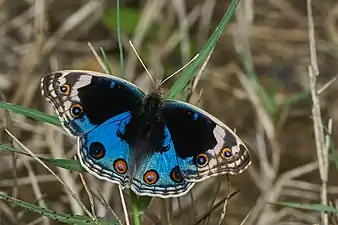Junonia
Junonia is a genus of nymphalid butterflies, described by Jacob Hübner in 1819.[1] They are commonly known as buckeyes, pansies or commodores. This genus flies on every continent except Antarctica. The genus contains roughly 30 to 35 species.
| Junonia | |
|---|---|
 | |
| Junonia villida | |
| Scientific classification | |
| Kingdom: | Animalia |
| Phylum: | Arthropoda |
| Class: | Insecta |
| Order: | Lepidoptera |
| Family: | Nymphalidae |
| Tribe: | Junoniini |
| Genus: | Junonia Hübner, [1819] |
| Type species | |
| Junonia evarete (Cramer, 1779) | |
| Species | |
|
About 30–35, see text | |
| Synonyms | |
| |
Description
These butterflies are medium to large (wingspan 40–110 mm). The ground colour is brown or grey suffused blue. Spots on the wings are orange, blue or pink and sometimes large. Many of the species can occur in several colour forms. The head is of moderate size with smooth, prominent eyes. The palpi are rather long, sharply pointed, ascending, generally convergent and scaly, sometimes more or less hairy. The antennae are of moderate length, generally with a rather short, abruptly formed club. The thorax is robust, ovate, rather sparingly clothed with hairs. The wing characters are: large, broad, variable in outline. Forewing: costa more or less arched, sometimes very strongly so; apical portion more or less produced, sometimes very prominent, with a strong projection on the hind margin at the extremity of the first discoidal nervule; hind margin always more or less dentate and emarginate, with, in many species, a considerable projection at extremity of third median nervule; inner margin nearly straight, or slightly emarginate about centre; discoidal cell generally closed by a slender nervule. Hindwing: costa strongly arched at base, and more or less so throughout; hind margin always more or less scalloped, sometimes simply rounded (without any marked projections), sometimes with a more or less elongate production of anal angle, and occasionally with a longer or shorter projection of hind margin at extremity of first median nervule; inner margins deeply grooved and entirely covering the under surface of the abdomen; discoidal cell generally open. The abdomen short, compressed, rather slender.
The larvae are rather stout, almost of equal thickness throughout, armed with strong branched spines; sometimes with two short, similar spines on head. The pupae are moderately angulated, with raised tubercles on the back, head slightly bifid. Sometimes hardly angulated, the anterior portions more rounded.
Biology
Junonia are good fliers. The larvae feed on a wide variety of plants, among others Labiatae, Acanthaceae, Amaranthaceae, Scrophulariaceae, Onagraceae, Leguminosae, Balsaminaceae, Gramineae, Melastomataceae, Plantaginaceae, Aucubaceae and Compositae.
Taxonomy
The leaf butterflies J. ansorgei and J. cymodoce (both from Africa) have traditionally been included in Kallima, but this genus is now usually limited to Asian species. Instead of being placed in Junonia, the two are sometimes awarded their own genus, Kamilla. The leaf butterfly J. tugela is sometimes included in Precis instead of Junonia.
The species in Junonia:[2][3][4]
- Junonia adulatrix (Fruhstorfer, 1903)
- Junonia africana (Richelmann, 1913)
- Junonia almana (Linnaeus, 1758) – peacock pansy
- Junonia ansorgei (Rothschild, 1899) – Ansorge's leaf butterfly
- Junonia artaxia Hewitson, 1864 – commodore
- Junonia atlites (Linnaeus, 1763) – grey pansy or gray pansy
- Junonia chorimene (Guérin-Méneville, [1844]) – golden pansy
- Junonia coenia Hübner, [1822] – (common) buckeye
- Junonia cytora Doubleday, 1847 (formerly Salamis cytora) – western blue beauty
- Junonia cymodoce (Cramer, [1777]) – western leaf, blue leaf butterfly
- Junonia divaricata C. & R. Felder, [1867]
- Junonia erigone (Cramer, [1775]) – northern argus
- Junonia evarete (Cramer, [1779])
- Junonia genoveva (Cramer, [1780])
- Junonia goudotii (Boisduval, 1833)
- Junonia gregorii Butler, [1896] – Gregori's brown pansy
- Junonia grisea Austin & Emmel, 1998 – gray buckeye
- Junonia hadrope Doubleday, [1847] – Volta pansy
- Junonia hedonia (Linnaeus, 1764) – brown pansy
- Junonia hierta (Fabricius, 1798) – yellow pansy
- Junonia intermedia (C. & R. Felder, [1867])
- Junonia iphita (Cramer, [1779]) – chocolate pansy
- Junonia lemonias (Linnaeus, 1758) – lemon pansy
- Junonia litoralis Brévignon, 2009
- Junonia natalica (Felder, 1860) – Natal pansy
- Junonia neildi Brévignon, 2004 – mangrove buckeye
- Junonia nigrosuffusa Barnes & McDunnough, 1916 – dark buckeye
- Junonia oenone (Linnaeus, 1758) – dark blue pansy
- Junonia orithya (Linnaeus, 1758) – eyed pansy or blue pansy
- Junonia pacoma Grishin, 2020 – Pacific mangrove buckeye
- Junonia rhadama (Boisduval, 1833) – brilliant blue
- Junonia schmiedeli (Fiedler, 1920)
- Junonia sophia (Fabricius, 1793) – little commodore
- Junonia stemosa Grishin, 2020 – twintip buckeye
- Junonia stygia (Aurivillius, 1894) – brown pansy or dark pansy
- Junonia terea (Druce, 1773) – soldier commodore or soldier pansy
- Junonia timorensis Wallace, 1869
- Junonia touhilimasa Vuillot, 1892 – naval pansy
- Junonia tugela (Trimen, 1879) – African leaf butterfly (moved to Precis tugela)
- Junonia vestina C. & R. Felder, [1867] – Andean buckeye
- Junonia villida (Fabricius, 1787) – meadow argus
- Junonia wahlbergi Brévignon, 2008
- Junonia westermanni Westwood, 1870 – blue spot pansy
- Junonia zonalis C. & R. Felder, [1867] – Caribbean buckeye
Gallery
 J. almana
J. almana J. artaxia
J. artaxia J. atlites
J. atlites.jpg.webp) J. chorimene
J. chorimene.jpg.webp) J. coenia
J. coenia J. goudotii
J. goudotii.jpg.webp) J. hedonia
J. hedonia_male.jpg.webp) J. hierta
J. hierta J. iphita
J. iphita J. lemonias
J. lemonias_(13606628924).jpg.webp) J. natalica
J. natalica J. neildi
J. neildi_(11-5-2018)_harshaw_road_rabbitbrush_patch%252C_santa_cruz_co%252C_az_-01_(45751087801).jpg.webp) J. nigrosuffusa
J. nigrosuffusa.jpg.webp) J. oenone
J. oenone J. orithya
J. orithya.jpg.webp) J. rhadama
J. rhadama_white_form_male.jpg.webp) J. sophia
J. sophia.jpg.webp) J. stygia
J. stygia.jpg.webp) J. terea
J. terea J. villida
J. villida_J.jpg.webp) J. zonalis
J. zonalis
References
- Hübner, J. Verzeichniss bekannter Schmettlinge, 17-176, 1819.
- "Junonia Hübner, [1819]" at Markku Savela's Lepidoptera and Some Other Life Forms
- Junoniini Archived 2010-06-11 at the Wayback Machine, Nymphalidae.net
- Cong, Q., Zhang, J., Shen, J.H., Cao, X.L, Brévignon, C. & Grishin, N.V. 2020. Speciation in North American Junonia from a genomic perspective. Systematic Entomology 45(4): 803–837. DOI: 10.1111/syen.12428.